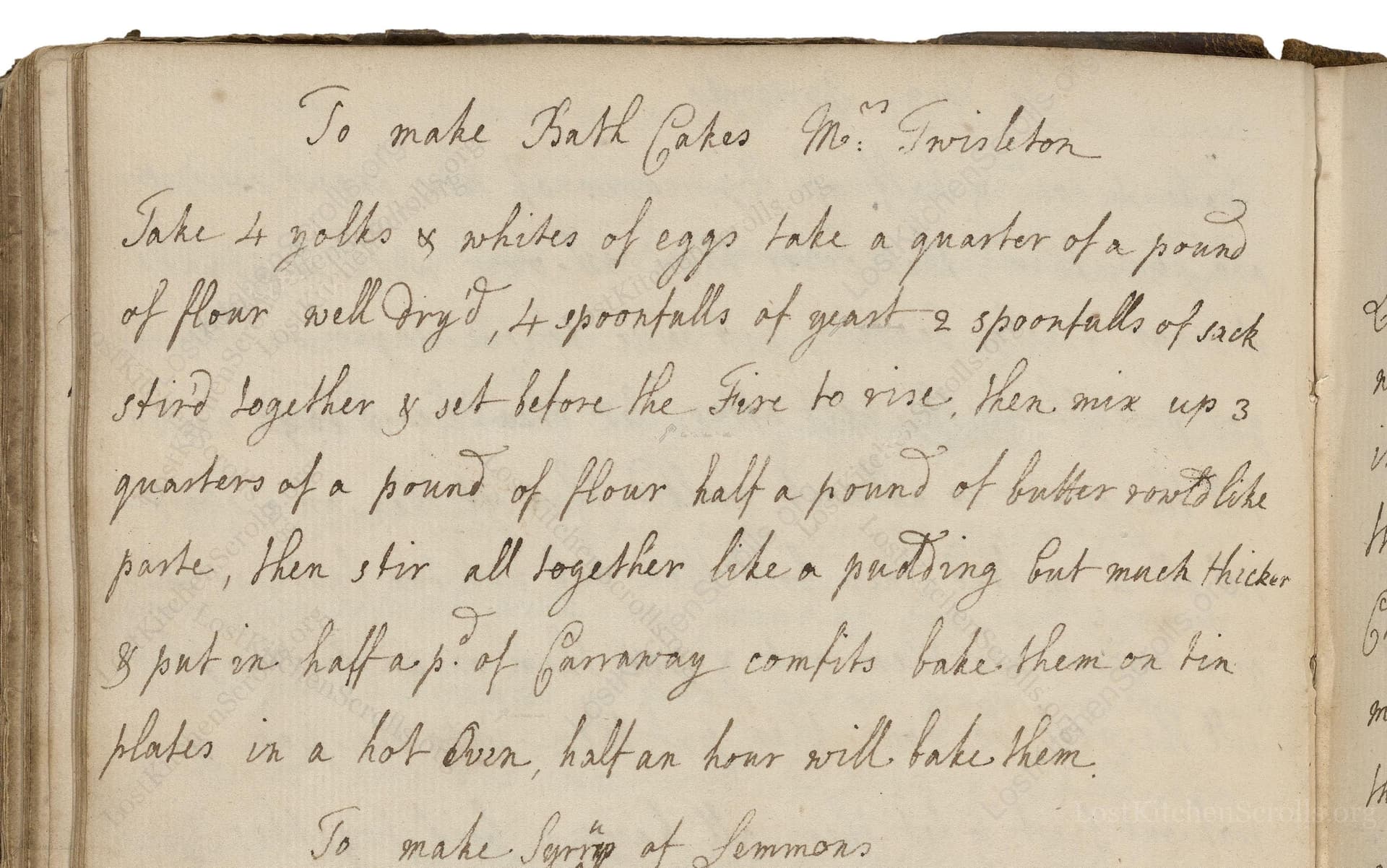To Make Bath Cakes Mr. Twisleton
From the treasured pages of Cookbook of Elizabeth Langley
Written by Elizabeth Langley

To Make Bath Cakes Mr. Twisleton
"Take 4 yolks & whites of eggs take a quarter of a pound of flour well Dry'd, 4 spoonfulls of yeast & 2 spoonfulls of sack stir'd together & set before the Fire to rise, then mix up 3 quarters of a pound of flour half a pound of butterr work'd like paste, then stir all together like a pudding but much thicker & put in half a p[ound] of carraway comfits bake them on tin plates in a hot Oven, half an hour will bake them."
Note on the Original Text
The recipe employs 18th-century spelling and grammar ('spoonfulls', 'stir'd', 'work'd'), and omits much of the detailing expected in modern recipes—the quantity for some steps is suggested by texture, not weights, and temperature is indicated as a 'hot oven,' relying on the cook’s intuition. Many ingredients would have differed slightly in texture and concentration compared to today. Carraway comfits are not common now; these were sugar-coated caraway seeds, used for crunch and sweetness. 'Sack' refers to a type of Spanish or Canary fortified wine, similar to dry sherry. The recipe’s brevity and precision speak to a world where skilled cooks understood the basics and interpreted these telegraphic instructions with practiced hands.

Title
Cookbook of Elizabeth Langley (1757)
You can also click the book image above to peruse the original tome
Writer
Elizabeth Langley
Era
1757
Publisher
Unknown
Background
Step into the Georgian kitchen with Elizabeth Langley's 1757 culinary collection, where refined techniques and delightful recipes await those with a taste for historic gastronomy.
Kindly made available by
Folger Shakespeare Library
This delightful recipe hails from 1757 and was recorded by Elizabeth Langley, a domestic cook working in Georgian England—a period obsessed with new baking techniques and delicate sweetmeats. Bath Cakes were fashionable treats in elite circles, inspired by spa tourism in Bath, where luxurious cakes and buns became popular fare. The use of rich ingredients and sack signals this was a celebratory bake, fit for a genteel household or a special gathering. Mr. Twisleton, likely a gentleman of note or patron of the Langley household, lent his name to this version of Bath Cakes, attesting to the personal nature of recipe sharing in the 18th century’s manuscript cookbooks.

Back in Elizabeth Langley’s day, all mixing would have been done by hand, using sturdy bowls (earthenware or wood). Doughs were mixed and kneaded on large wooden tables. The cakes were baked on tin plates or shallow tins, and the oven would have been a wood-fired or coal-heated brick oven, monitored by experience rather than by a temperature gauge. For rising, they would have left the yeast mixture near the hearth or another warm spot to encourage fermentation. Butter was worked by hand, rubbed into the flour until it resembled pastry dough.
Prep Time
20 mins
Cook Time
30 mins
Servings
10
We've done our best to adapt this historical recipe for modern kitchens, but some details may still need refinement. We warmly welcome feedback from fellow cooks and culinary historians — your insights support the entire community!
Ingredients
- 4 egg yolks
- 4 egg whites
- 4 oz plain flour (well dried)
- 4 tablespoons (2 fl oz) fresh yeast
- 2 tablespoons (1 fl oz) sack (substitute: dry sherry)
- 12 oz plain flour
- 8 oz unsalted butter
- 8 oz caraway comfits (substitute: caraway seeds + 2 tbsp sugar)
Instructions
- To prepare Bath Cakes as per Mr.
- Twisleton’s 1757 recipe, begin by combining 4 egg yolks and 4 egg whites in a large bowl.
- Add 4 oz of plain flour (well-dried, meaning lightly warmed in the oven to remove moisture), 4 tablespoons (about 2 fl oz) of fresh yeast, and 2 tablespoons (about 1 fl oz) of sack (a type of historical fortified white wine, substitute with dry sherry if needed).
- Stir together and leave the mixture somewhere warm to rise slightly.
- Separately, rub 12 oz of flour with 8 oz of butter until you have a texture like pastry or rough breadcrumbs.
- Mix everything together—the egg-yeast mixture with the flour-butter mixture.
- The batter should be much thicker than pudding, more like a heavy dough.
- Finally, fold in 8 oz of caraway comfits (sugar-coated caraway seeds, or use regular caraway seeds with a tablespoon or two of sugar as a substitute).
- Spoon the mixture onto greased baking trays or line tins and bake in a hot oven (around 400°F) for about 30 minutes, or until golden.
- Enjoy warm.
Estimated Calories
430 per serving
Cooking Estimates
This recipe takes about 20 minutes to prepare and 30 minutes to bake. Each serving has around 430 calories. The recipe makes 10 Bath Cakes.
As noted above, we have made our best effort to translate and adapt this historical recipe for modern kitchens, taking into account ingredients nowadays, cooking techniques, measurements, and so on. However, historical recipes often contain assumptions that require interpretation.
We'd love for anyone to help improve these adaptations. Community contributions are highly welcome. If you have suggestions, corrections, or cooking tips based on your experience with this recipe, please share them below.
Join the Discussion
Rate This Recipe

Den Bockfisch In Einer Fleisch Suppen Zu Kochen
This recipe hails from a German manuscript cookbook compiled in 1696, a time whe...

Die Grieß Nudlen Zumachen
This recipe comes from a rather mysterious manuscript cookbook, penned anonymous...

Ein Boudain
This recipe comes from an anonymous German-language manuscript cookbook from 169...

Ein Gesaltzen Citroni
This recipe, dating from 1696, comes from an extensive anonymous German cookbook...
Browse our complete collection of time-honored recipes



